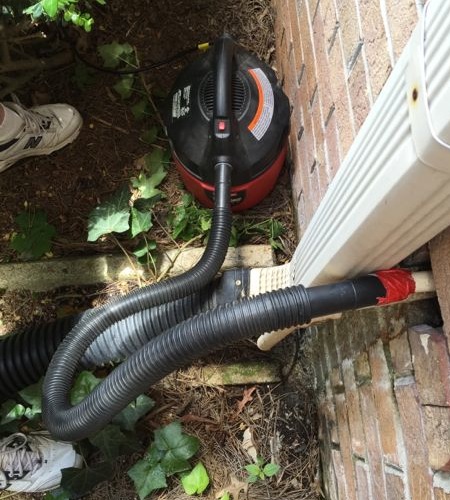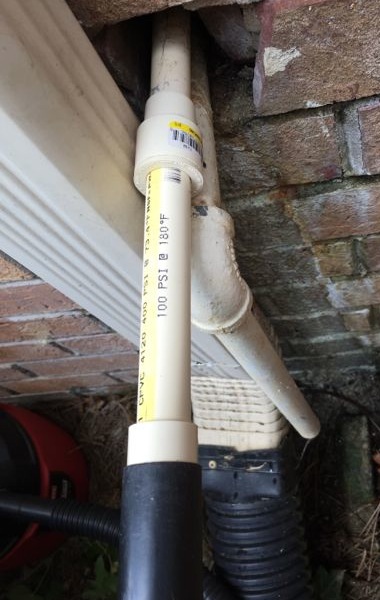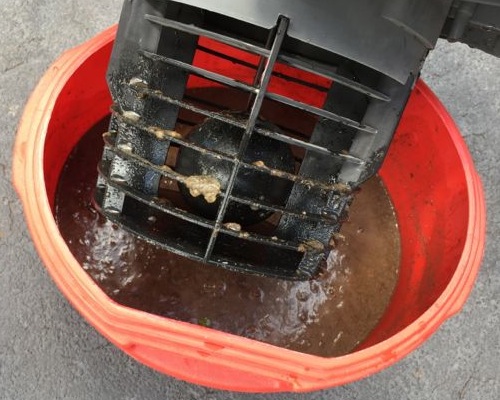
Image Credit: Energy Vanguard
An air conditioner does two jobs: It cools down the air and it dehumidifies the air. If you live in a dry climate, you don’t want the AC to dehumidify much because it uses extra energy and makes you spend more on lip balm and hand lotion. If you live in a humid climate, you really want it to do that second job as well as it can to keep your indoor air dry and comfortable. But where does all that condensate go?
In most homes, it goes outdoors through a pipe, like the one above. Sometimes there’s a condensate pump that pumps it out, but most often it drains by gravity alone. Occasionally that condensate line gets clogged. This happened at my condo just as the air conditioning season started cranking up. (We live in Atlanta, Georgia, a mixed-humid climate.) Gunk in the pipe built up to the point where it was barely draining. We could run the AC for a little while and then we’d have to turn it off again as the pipe filled up.
Cleaning out the gunk
Over the Memorial Day weekend, I tackled the problem. One of the best ways to do so is with good old air pressure. If you can close off all escape routes except the one in the direction of the clog, you can shoot positive pressure into the pipe near where the indoor unit is located. That should blow the clog out the other end. In our case, that wasn’t an option because our condensate line is connected to our upstairs neighbor’s air conditioner, too. It’s not the best option anyway because it can blow your condensate line apart if you have any weak connections.
So I got out my little wet-dry shop vac and set it up to suck the gunk out at the end of the pipe. The photo below shows the setup.
I was hoping to avoid a trip to the hardware store, so I used red duct tape to try to make an airtight connection between the shop vac hose and the condensate line. It didn’t work.
I took the shop vac hose with me to the store and bought some fittings in the plumbing department. I hooked it all up (photo at left) and got a nice, airtight connection this time. With the taped connection, I got maybe half a cup of water out of the pipe.
With the airtight connection, I got the bucket full of crud you see at left. (The black plastic object with the grid pattern is part of the shop vac.)
If you really want to see how bad it was, watch the short video below and you can see my wife pouring it out.
Yes, all that gunk was in our condensate line. One problem with condensate lines is that algae can grow in them. In our case, there’s also a lot of sediment in that bucket, possibly from a corroded evaporator coil. We replaced our AC in 2009 and the condensate line hasn’t been cleaned since then, so some of that crud could have been from our old unit. In fact, I’m guessing this is the first time this condensate line has been cleaned in the 45 years it’s been there.
A few condensate line products
If you haven’t thought about your condensate line lately (or ever), this would be a good time to do so. You can have your HVAC company make sure it’s clean, or you can get the tools and do it yourself. To keep it clear, you can use an algaecide that’s safe for air conditioners. An HVAC company can recommend one. (Don’t use bleach! It can cause a host of problems.) In hot-humid climates like Florida especially, clogged condensate lines are a frequent problem.
When I posted this article in the Energy Vanguard Blog, some of the commenters mentioned products that make condensate line maintenance easier. (There was also a strange discussion about Legionnaire’s Disease.) Here are three.
Rectorseal Mighty Pump. This is a manual pump you can use to put positive or negative pressure on the drain line. No electricity needed. It comes with the connectors you need to hook up to standard condensate lines.
Rectorseal Waterless Trap. This add-on can serve a couple of different purposes with condensate lines. If the trap is in unconditioned space in a climate zone where water in the trap can freeze, this waterless trap might be the answer. Regan Murphy, who posted the link, wrote that it’s also helpful for condensate lines plumbed to the sewer line by keeping sewer gases out of the house without having to worry about keeping water in the trap.
All-Access condensate clean-out device. This may be the coolest of the three products. You cut out a section of the condensate line and install this little device. Then you can use it to clean out the drain line with positive or negative pressure. You can add algaecides there. You can also use it to flush the line with water. It’s a really clever little device. Watch the videos (especially the first one) on their page to see all it can do.
A little preventive maintenance now could save you thousands of dollars in water damage repairs and the loss of your air conditioner. And you know the most likely time for these to problems to occur is when it’s really, really hot outside.
Allison Bailes of Decatur, Georgia, is a speaker, writer, energy consultant, RESNET-certified trainer, and the author of the Energy Vanguard Blog. Check out his in-depth course, Mastering Building Science at Heatspring Learning Institute, and follow him on Twitter at @EnergyVanguard.
Weekly Newsletter
Get building science and energy efficiency advice, plus special offers, in your inbox.


















3 Comments
good for routine cleanout, too
While my condensate line is very short and just drops immediately
into the pump when it's attached, this is how I suck the bulk of
the water out of the AHU tray at the end of cooling season:
http://techno-fandom.org/~hobbit/hse/log/257215/1492ahu-vacout.jpg
The wet-vac hose fits very nicely over the PVC and keeps itself
there while the vac is running. Usually pulls out a couple of
pints worth, which is then not going to sit there under the coil
and be a mold farm while slowly evaporating off.
_H*
Another condensate cleanout
I've seen this version at trade shows. It strikes me as a good idea. I wonder how many HVAC techs include one in new installations?
http://www.rectorseal.com/index.php/cleartrap/
Allison, Do you see the need to neutralize AC evaporator coil or HPWH condensate (NOT sealed combustion condensate)? I see clear explanations of why sealed combustion condensate is acidic but I cannot find any mentions of condensate from a regular evap coil (or heat pump water heater) being acidic (ostensibly it just comes from the air inside the house). I have cast iron drain plumbing so that's why I ask.
Log in or create an account to post a comment.
Sign up Log in